Tagged with 'Cultured pearls'


-
What are Baroque Pearls ?
What are Baroque Pearls ?
When describing the shape of a pearl, baroque is a term that is used to describe irregular and non-symmetrically shaped pearls that have been formed in freshwater mussels and saltwater oysters. Baroque pearls are not round, drop or button shaped.
The shape of a baroque saltwater pearl is caused by the uneven deposition of nacre by the oyster around its nucleus.
Up to 40% of the harvest of cultured pearls from a Tahitian pearl farm can be baroque in shape. These generally are found to be smaller in size, with true Tahitian baroque pearls greater than 12mm being very rare and sought after.
Larger Australian South Sea baroque pearls are also unusual and particularly beautiful, with a silver blue overtone and beautiful lustre.
Baroque pearls have been used for many years to create wonderful pieces of jewellery. One of the most famous historical pieces of baroque pearl jewellery is The Canning Jewel. To be found today in London’s Victoria & Albert Museum, it is believed to have been made in the 19th century and uses a number of baroque pearls to create its mythical Merman figure.
Baroque pearls today are less extravagantly worn, but are still highly sought after for their individual shapes and colours. Today, baroque pearls are inspiring a new generation of contemporary fine jewellers, from Melanie Georgacopolous to Mizuki, drawn to their unique forms.
At Winterson, we stock a range of necklaces, baroque pearl earrings, sautoirs and bracelets made from Tahitian baroque pearls. Each pearl is unique and its contours, circles and peacock colour creates a sophisticated and highly contemporary look.
-
How to tell Real Pearls from an Imitation Pearl
How to tell Real Pearls from an Imitation Pearl
Is there an obvious difference between real and fake pearls ? Here are a few tips on how to tell real pearls from an imitation pearl.
It is often said that a factory-made pearl will be very smooth to the touch if passed against a tooth, whereas a natural or cultured pearl is more textured due to its layers of organic matter called nacre. We do not recommend this method as it can be damaging to the real pearl. Never be tempted to bite into the pearl itself.
Although specialist laboratories can provide an accurate assessment of a pearl by performing a range of tests including X-ray examination of the pearl itself, it can sometimes be possible in expert hands to identify excellent imitation pearls through touch and observation.
The density, weight and sound when you click imitation pearls together can be quite different to that of real pearls.
Another simple method used is to examine the drill hole in the pearl.
In contrast to natural and cultured pearls, the layering of varnish in factory-produced imitation pearls can often be readily identified at this point, perhaps by identifying some melting of the varnish at the actual drill hole.
-
What is the Lustre of a Pearl ?
What is the Lustre of a Pearl ?
A pearl's iridescence is known as lustre and is absolutely unique to pearls, different to any other gemstone. When grading pearls, highly prized pearls will have strong depths of colour and a shiny lustre. Without lustre, pearls can be dull, opaque and lifeless.
The factors that determine a pearl’s lustre are highly complex, being determined physically by the way that light diffracts through the physical structure of the layered nacre of the pearl. The thickness of the nacre is caused by how long the pearl is left in the oyster. Generally, pearls with the greatest thickness of nacre will have the deepest lustre.
The colour of a pearl mainly reflects the type of oyster or mussel that the pearl was cultured in. However, a pearl’s complex overtones of colour can also be due to the temperature of the water, its cleanliness and even the plankton that the oyster feeds on. For example, colder water can introduce a light grey colour to a pearl and dirty water will create a brown overtone.
Unfortunately once the pearl is removed from the oyster, lustre doesn’t improve with age like a fine wine.
By selecting good quality pearls, and with careful cleaning, the lustrous qualities of a beautiful pearl can, however, be maintained over time. For more information, read our Buying Guide on how to take care of your pearls.
-
The Beauty of South Sea Pearls
The Beauty of South Sea Pearls
Naturally occurring South Sea pearls are virtually unknown today on the world market. Although experiments in culturing South Sea pearls began as early as 1912, it was not until 1954 that the first successful operation began in Burma.
The size and quality of the pearls produced since then have been sensational, with cultured South Sea pearls being regarded as the most luxurious types of pearls today.
The oyster used by growers is the large Pinctada maxima oyster, which can be found in two varieties, the silver-lipped and yellow-lipped oysters. The Pinctada maxima oyster can be as large as 30cm in diameter and up to 3 years in age before grafting operations begin.
The most popular colour of South Sea pearls has been white, combined with delicate overtones of silvers and pinks, and is produced by the silver-lipped oyster found in ocean waters mainly off the coasts of Australia and Indonesia.
The yellow-lipped oyster, found off the coast of the Philippines and Indonesia, produces highly fashionable golden pearls with overtone colours of peach and even red. The best quality golden pearls can command significant prices today at auction.
The thickness of nacre on a South Sea pearl contributes to a rich depth of lustre and shine unmatched by many other pearls. These are the largest pearls being cultured today, typically being found in sizes between 8mm and 16mm and sometimes even exceeding 20mm in diameter.
Available at Winterson in a number of contemporary and classic South Sea pearl necklaces, pendants and South Sea pearl earrings, these stunning designer pearls really make a unique and beautiful gift.
-
What Are Tahitian Pearls ?
What Are Tahitian Pearls ?
The most exotic and original of pearls are farmed in the lagoons of five archipelagos of atolls and islands, mainly in French Polynesia.
Also known as ‘black pearls’, Tahitian pearls are produced in many mysterious colours such as silver, grey, pistachio, peacock and aubergine. Combined with classic round and baroque shapes, these colourful pearls have become highly fashionable and sought after in recent years.
Tahitian pearls are cultured in the large black lipped oyster Pinctada margaritifera cumingii. Unlike most pearl-producing molluscs which are grown in a hatchery to adulthood, larvae of the Pinctada margaritifera cumingii are often collected in the wild.
Tahitian pearls are regularly grown between 8 and 18mm in diameter, becoming more valuable with increasing lustre and size. To guarantee their exceptional quality, all Tahitian pearls are graded using X-ray technology to confirm each pearl has a minimum of 0.8mm of nacre before they are accepted for export.
Although Tahitian pearls can be perfectly round, their odd shapes and circles can also contribute to their mystery. In Imperial China, the Tahitian black pearl was regarded as a symbol of wisdom guarded between the teeth of a dragon.
Today, at Winterson we are proud to offer a more simple way to wear these exceptional pearls, with a beautiful selection of Tahitian pearl necklaces, pendants, rings, bracelets and Tahitian pearl earrings.
-
What are Japanese Akoya Pearls?
What are Japanese Akoya Pearls?
The iconic Akoya pearl is probably the most well known type of pearl and is prized for the quality of its nacre and lustre and for its near perfect round shape.
Since the first successful attempts to culture an Akoya pearl over a century ago, Akoya pearls are considered to be one of the most dazzling types of pearls available.
These saltwater pearls are cultured in the Pinctada fucata oyster, which is historically farmed in Japanese coastal waters. Other regions that are known for culturing Akoya pearls include China and Vietnam.
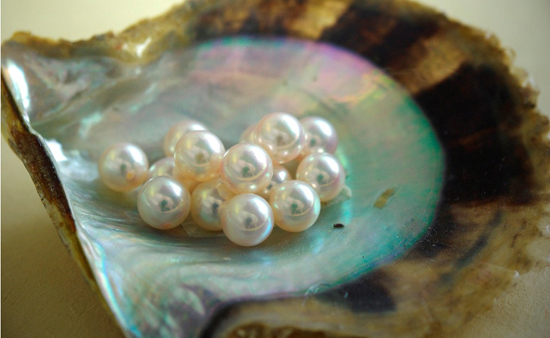
The oyster itself is small in comparison to other species and typically produces just one pearl of between 3mm and 10mm in diameter in each individual oyster.
Seed pearls are tiny pearls smaller than 3mm that are also produced in this oyster as a by-product of pearl culturing. These tiny gems give a delicate finish to jewellery as seen the Beau Seed Pearl and Diamond Ring by designer Alice Cicolini below.
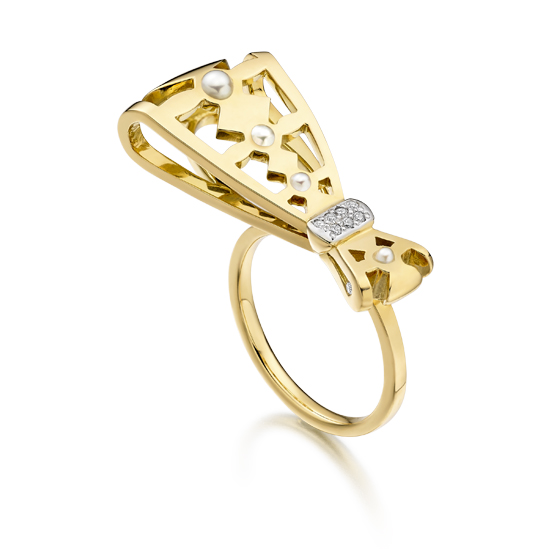
Due to increasing levels of water pollution, Akoya pearls larger than 9.5mm of good quality are rarely cultured today and command increasingly high values compared to pearls that are more than 0.5mm smaller in diameter.
The proportion of round pearls produced by the Akoya oyster is relatively high and their near perfect shape has been an emblem of their quality together with their characteristic white colour.
Although at first glance, Akoya pearls may appear white, they often have overtones of pink, cream, silver and blue. Occasionally the pearls may have a rich cream to golden colour such those in the golden Akoya pearl necklace below.
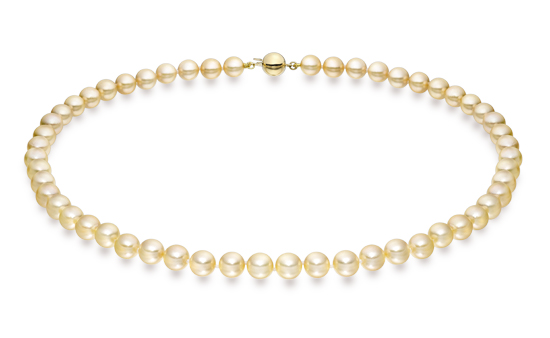
The classic pink overtone is usually as a result of a traditional dye treatment by Japanese farmers called 'pinking'. Akoya pearls never come in dark hues that are typical of Tahitian pearls and black Akoya pearls are always the result of colour treatments.
Their size, lustre and colour mean that Akoya pearls are very well suited to making classic designs of Akoya pearl necklaces, bracelets, pendants, rings and Akoya pearl earrings.
A jewellery box staple is the Akoya pearl jewellery set, worn as every day attire, a wedding or an evening occasion.
Reinventing itself, the beloved Akoya pearl is also favored by designers in contemporary designs such as this Tsavorite Garnet and Akoya pearl pendant by designer Sophie Breitmeyer, where the classic round qualities of the lustrous pearl is contrasted with the more colourful modern gemstone.
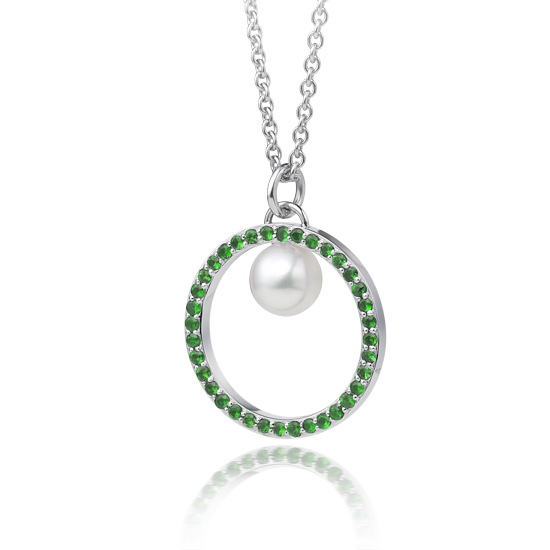
If you would like to learn more about pearls, and what you should look for, read our Buying Pearls guide here.
-
Freshwater Pearls from a Mussel
Freshwater Pearls from a Mussel
Freshwater pearls are cultured around the world, including in countries such as Japan and the USA. Over the last twenty years the Chinese have perfected the production of culturing pearls in freshwater mussels, which are farmed in lakes and streams.
Most freshwater pearls available today are produced in China and make really lovely pieces of jewellery. The best quality freshwater pearls sit comfortably alongside the finest Akoya, Tahitian and South Seas pearls and can also offer great value.
The triangular-shaped shell mussel Hyriopsis cumingii is used to produce up to 50 freshwater pearls in each mussel, depending on the size and quality desired. In contrast to saltwater pearl culturing, freshwater pearls generally need no nucleus, with the pearl only being produced by the mussel once a piece of nacre-producing tissue is inserted into the mussel to create the pearl sac.
The size of these cultured freshwater pearls can vary widely from tiny poppy seed pearls to more regular pearls between 6 and 12mm. Very recently developed grafting techniques have also introduced a nucleus to the mussel to culture even larger freshwater pearls.
The placed position of the nacre-producing tissue and the shape of a nucleus in the mussel can produce different shapes of pearls such as round, semi-round, oval, button, baroque, coin and drop shapes.
As well as being capable of producing consistently high quality pearls, freshwater mussels cleverly produce a dazzling rainbow of colours including shades of white, apricot, lavender and pink Freshwater pearls.
With this quality and diversity of freshwater pearls, we can offer a range of fashionable and classic freshwater pearl necklaces, freshwater pearl earrings and jewellery that we hope you will love.
-
The Emergence Of Cultured Pearls
The Emergence Of Cultured Pearls
Following the invention of the cultured pearl, a revolution began to take place in the world of pearls. Pearl diving and over-fishing in the late 19th century had driven prices of natural pearls soaring.
The advent of techniques for culturing pearls in saltwater oysters brought these fabulous gems within the reach of many, without depleting further the world’s natural mollusc beds. The method used for the creation of a cultured pearl is still widely used today.
A small round bead of shell material from a mussel and a piece of nacre-producing tissue from another oyster is inserted into a saltwater member of the Pintadine shellfish family. This highly skilled procedure is called a graft.
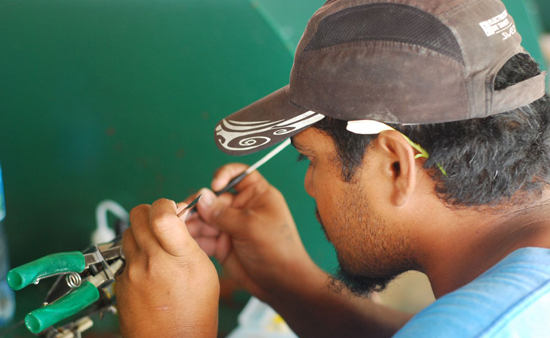
The nacre-producing tissue forms a small pearl sac around the bead and then gets to work covering the irritant with layers of nacre. Once the process has started, the pearl farmer has little control over of the final size, shape and colour of the pearl produced.
Once grafted less than 5% of these Pintadine shellfish, commonly referred to as oysters, go on to produce the best quality cultured pearls. Each pearl is unique and individual.
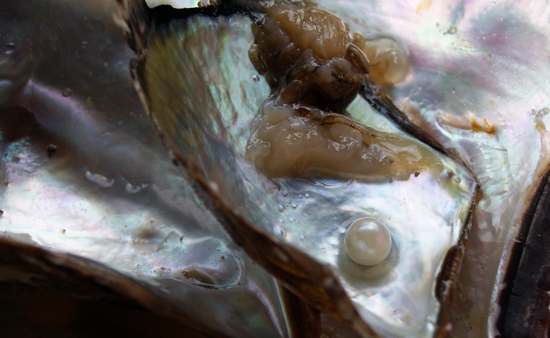
Today these grafting techniques are used in countries such as Japan, Indonesia and Australia to produce a wide variety of cultured pearls in both saltwater and freshwater molluscs.
This amazing diversity has inspired new directions of pearl jewellery and fashion beyond the classic white pearl necklace.
The next articles in this series will look in turn at the many different types of cultured pearl, in particular Freshwater, Akoya, Tahitian and South Sea pearls.
-
The Cartier Necklace And Mrs Plant
The Cartier Necklace And Mrs Plant
In 1917 enthusiastic New-Yorkers gawped at a double string necklace of natural pearls valued at $1 million, and said to be the finest in the Western world, that were being exhibited by jeweller Pierre Cartier.
A natural pearl is a pearl that has been formed entirely accidentally and with no intervention from humans at all.
Falling in love with the necklace, entrepreneurial Maisie Plant offered Cartier a swap of her 52nd Street and Fifth Avenue townhouse for the item. For an additional $100 in cash, Cartier bought the landmark building that it still occupies today.
Two years later, Kokichi Mikimoto, an innovative entrepreneur from Japan that was widely credited with developing a patented method for producing the cultured pearl, launched his products onto the London market at a 25% discount to the price of natural pearls.
By the time Mrs Plant died in 1956 the Cartier necklace of pearls was auctioned off for just $150,000 as cheaper cultured pearls emerged and prices of natural pearls fell. In recent times, however, natural pearls have seen a resurgence of desirability, with the famed Baroda Pearls, a double strand of 68 natural pearls, being sold at auction at Christies in 2007 for a record $7.1 million.
All the pearls that Winterson sells are cultured pearls. We take very great care in selecting the best available for use in our jewellery.
-
How Are Pearls Formed
How Are Pearls Formed
A natural pearl might start with an itch, although most pearl experts now agree that the 'grain of sand' is nor more than a myth.
When a small seed of material such as a parasite becomes trapped within an oyster or mussel's shell, nature gets to work. The shellfish slowly deposits layers of organic material called nacre around the source of its irritation.
Nacre is made from two forms of calcium carbonate called Aragonite and Calcite, which are found in the interior lining of shellfish that is often called ‘mother-of-pearl’. These are linked together by a little organic protein called Conchiolin, which is identical to that found in human hair and fingernails. Together these substances form the nacre.
Over time, layering of this nacre by the shellfish forms a smooth surface around the foreign material slowly transforming it into a beautiful pearl, unique in its shape, size and colour. The difference from one pearl to another lies in the shape and placement of crystals of Aragonite and Calcite that are being held in place by Conchiolin.
In our next articles we shall look at the differences between natural and cultured pearls.